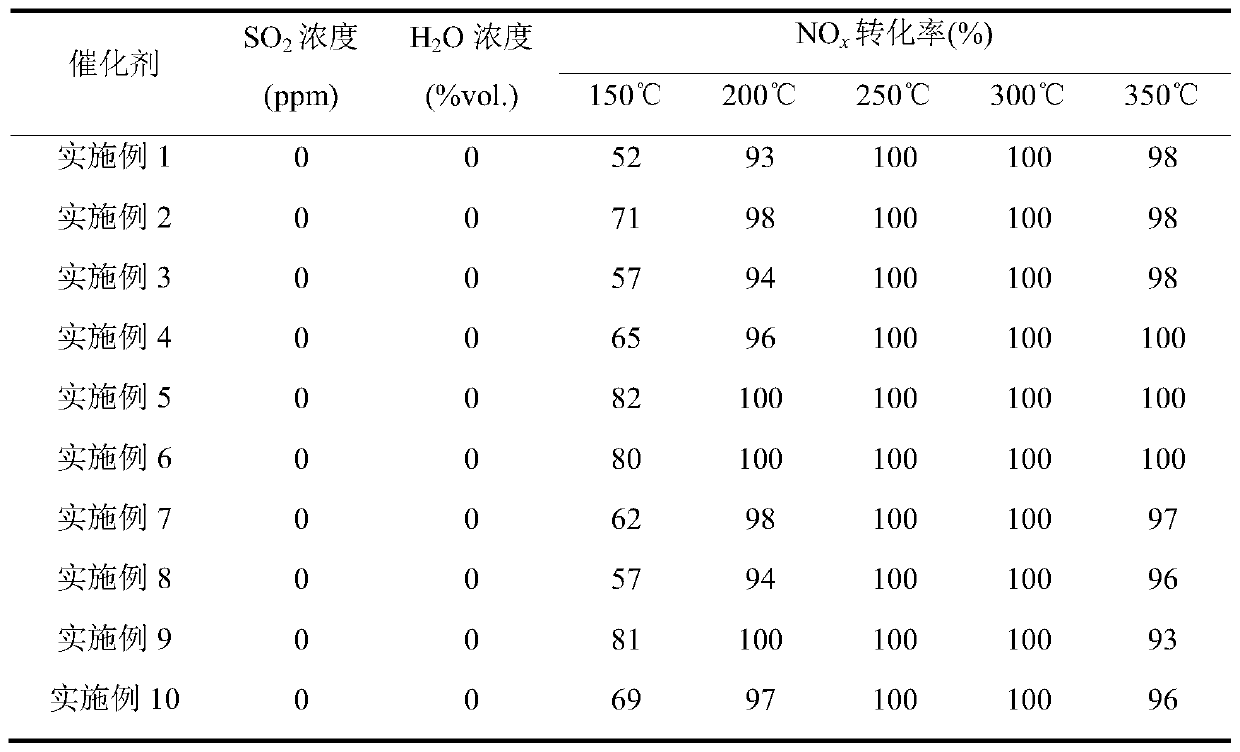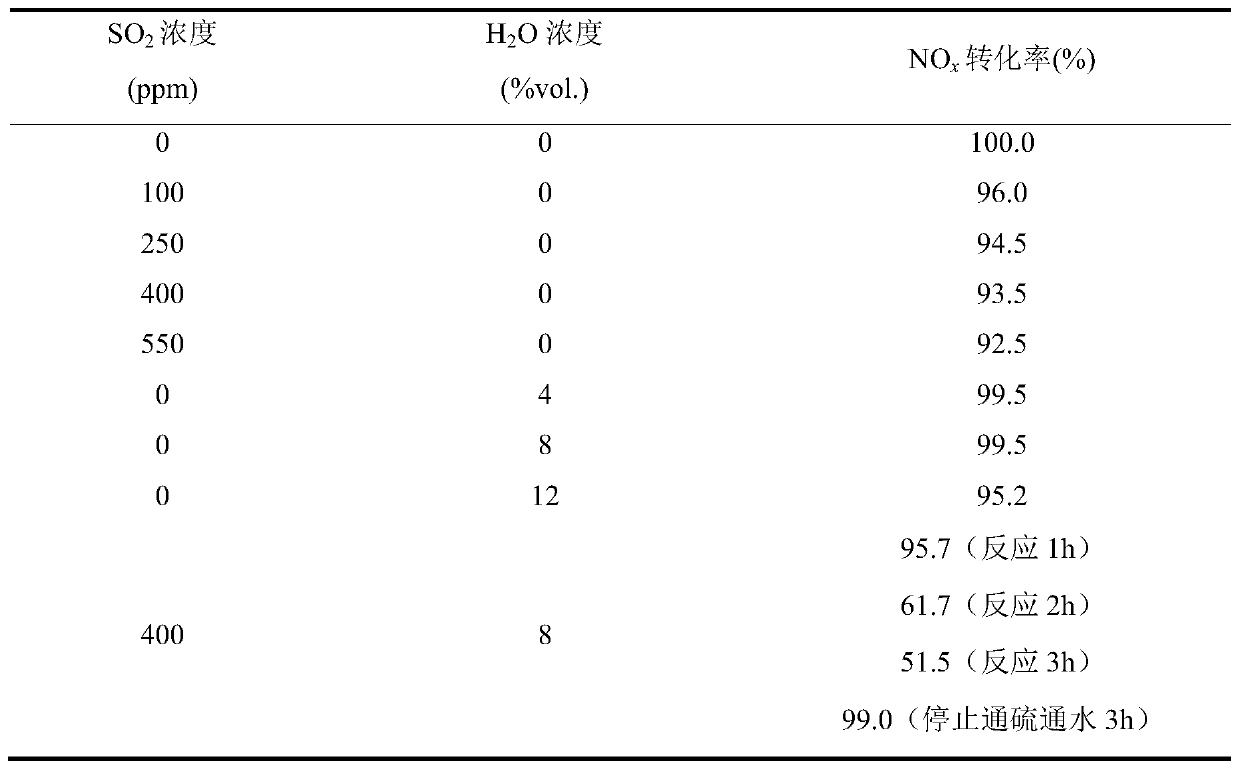Copper-doped low-temperature phosphomolybdic acid denitration catalyst and preparation method thereof
A low-temperature denitration and phosphomolybdic acid technology, applied in chemical instruments and methods, physical/chemical process catalysts, separation methods, etc., can solve problems such as poor ability, increase exposure, enhance redox and electron storage capacity, improve The effect of low temperature denitration activity
- Summary
- Abstract
- Description
- Claims
- Application Information
AI Technical Summary
Problems solved by technology
Method used
Image
Examples
Embodiment 1
[0060] Step 1: Preparation of Active Components
[0061] The first step, weigh 1g phosphomolybdic acid, 0.005g PEG (by weighing 0.5% by mass of phosphomolybdic acid) and 2g copper nitrate (control Cu and Mo mol ratio to be 2: 1) and put them in the crucible, add 40ml distilled water to dissolve , stir at a constant speed for 1 h on a magnetic stirrer, and control the stirring temperature to be 25 °C; in the second step, dry the mixture in the first step at a constant speed on a magnetic stirrer, evaporate the water to dryness, and control the drying temperature to be 85 °C; In the third step, the mixture in the second step is placed in a drying oven for constant temperature drying, and the drying temperature is controlled to be 105°C; in the fourth step, the mixture dried in the third step is placed in a muffle furnace for calcination at 350°C for 3 hours. The active ingredient is obtained after cooling.
[0062] Step 2: Preparation of the catalyst
[0063] In the first step...
Embodiment 2
[0065] Step 1: Preparation of Active Components
[0066] The first step, weigh 1g phosphomolybdic acid, 0.005g PEG (by weighing 0.5% of phosphomolybdic acid mass) and 4.7658g copper nitrate (control Cu and Mo mol ratio to be 3: 1) put into the crucible, add 40ml distilled water Dissolve, stir at a constant speed on a magnetic stirrer for 1 h, and control the stirring temperature to be 25 °C; in the second step, dry the mixture in the first step at a constant speed on a magnetic stirrer, evaporate the water to dryness, and control the drying temperature to be 85 °C; In the third step, the mixture in the second step is placed in a drying oven for constant temperature drying, and the drying temperature is controlled to be 105°C; in the fourth step, the mixture dried in the third step is placed in a muffle furnace for calcination at 350°C for 3 hours. , the active component is obtained after cooling.
[0067] Step 2: Preparation of the catalyst
[0068] In the first step, weigh 0....
Embodiment 3
[0070] Step 1: Preparation of Active Components
[0071] The first step, take by weighing 1g phosphomolybdic acid, 0.005g PEG (by weighing 0.5% of phosphomolybdic acid quality) and a certain amount of copper nitrate (controlling the Cu and Mo mol ratio to be 4: 1) put into the crucible, add 40ml distilled water Dissolve, stir at a constant speed on a magnetic stirrer for 1 h, and control the stirring temperature to be 25 °C; in the second step, dry the mixture in the first step at a constant speed on a magnetic stirrer, evaporate the water to dryness, and control the drying temperature to be 85 °C; In the third step, the mixture in the second step is placed in a drying oven for constant temperature drying, and the drying temperature is controlled to be 105°C; in the fourth step, the mixture dried in the third step is placed in a muffle furnace for calcination at 350°C for 3 hours. , the active component is obtained after cooling.
[0072] Step 2: Preparation of the catalyst ...
PUM
| Property | Measurement | Unit |
|---|---|---|
| specific surface area | aaaaa | aaaaa |
| specific surface area | aaaaa | aaaaa |
Abstract
Description
Claims
Application Information
 Login to View More
Login to View More - R&D
- Intellectual Property
- Life Sciences
- Materials
- Tech Scout
- Unparalleled Data Quality
- Higher Quality Content
- 60% Fewer Hallucinations
Browse by: Latest US Patents, China's latest patents, Technical Efficacy Thesaurus, Application Domain, Technology Topic, Popular Technical Reports.
© 2025 PatSnap. All rights reserved.Legal|Privacy policy|Modern Slavery Act Transparency Statement|Sitemap|About US| Contact US: help@patsnap.com


